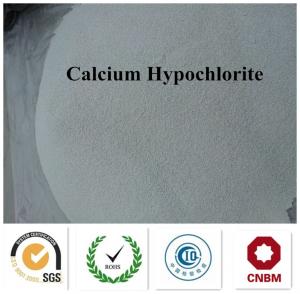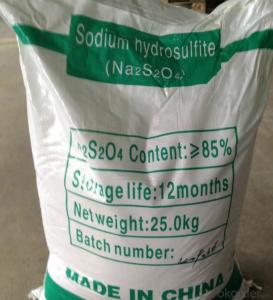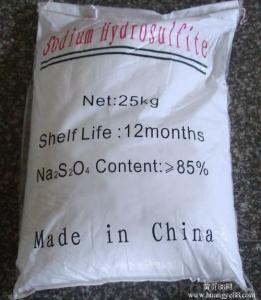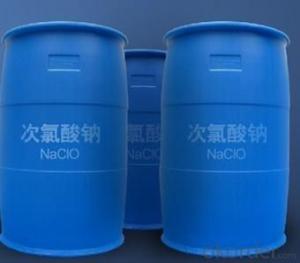Sodium Hydrosulphite with Best Quality and Compeitive Price
- Loading Port:
- Qingdao
- Payment Terms:
- TT or LC
- Min Order Qty:
- 22 m.t.
- Supply Capability:
- 3000 m.t./month
OKorder Service Pledge
OKorder Financial Service
You Might Also Like
1.Structure of Sodium Hydrosulfite Description:
Commodity name: Sodium Hydrosulfite Na2S2O4 Sodium Hydrosulfite Sodium Dithionite Price
Molecular formula:Na2S2O4
Molecular weight:174
CAS Number 7775-14-6
H.S code 28311010
UN number 1384
Class 4.2
2.Main Features of Sodium Hydrosulfite:
It is a versatile chemical that's used in the manufacture of a variety of products we all use every day,
from photographic film to wine; from fine writing papers to leather goods; from colored fabrics to metal recovery.
While the applications for this chemical workhorse are as vast and as varied as the industries that use it,
in most cases, sodium hydrosulfite performs one of the following three roles:
1) As reducing agent, hydrosulfite chemically reduces othercomponents by donating an electron or electrons
2) As sulfonating agent, hydrosulfite adds sulfur to another chemical compound
3) As cation source, hydrosulfite adds a cation, or sodium, to a product system
3.Sodium Hydrosulfite Images


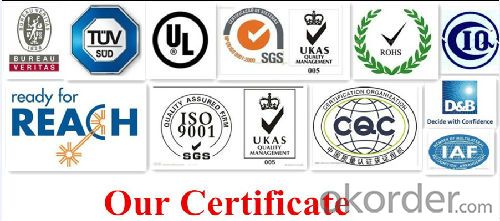
4.Sodium Hydrosulfite Specification
Standard:HG2932-1999
Index | Technical Grade HG/T 2074-2011 | Food Additive GB 22215-2008 | ||
Na2S2O4, | ≥ 90% | ≥ 88% | ≥ 85% | ≥ 88% |
Iron (Fe), | ≤20ppm | ≤ 20ppm | ≤ 20ppm | ≤ 20ppm |
Zinc (Zn), | ≤ 1ppm | ≤ 1ppm | ≤ 1ppm | ≤ 1ppm |
solution appearance | clear | clear | clear | clear |
EDTA, | / | / | / | qualified |
Arsenic(As), | / | / | / | ≤ 1ppm |
Other heavy metal( As Pb), | ≤ 1ppm | ≤ 1ppm | ≤ 1ppm | ≤ 1ppm |
Formate (As HCHO), | / | / | / | ≤ 0.05% |
water insolubles, | ≤ 0.05% | ≤ 0.05% | ≤ 0.05% | / |
Cadmium (Cd) | / | / | / | ≤ 2ppm |
Plumbum (Pb) | / | / | / | ≤ 5ppm |
5.FAQ
4, how about your packing?
My main packing is 25kg or 1000kg PP PE or kraft bag , with or withour pallets,with or without anticaking. We also can make packing and shipping mark are your ask, such as 50kg/50bl bag.
5, how long time you can make the shipping?
We can make the shipping within 5-10day after confirm the order.
6, why you buy from me?
We have stable quolity and price, not best quolity and price. It is not true for best quolity and best price. Our factory is manufacture according the BP USP and FCCIV terms. We have in this line for more than 8 years. We are one of the biggest exporter from Qingdao port.
- Q: What fruit contains more minerals?
- Persimmon contains a lot of carbohydrates, per 100 grams of persimmon containing 10.8 grams, mainly sucrose, glucose and fructose, which is why we feel very sweet persimmon persimmon in the other nutrients are not only contain a small amount of fat , Protein, calcium, phosphorus, iron and vitamin C. In addition, persimmon is rich in pectin, it is a water-soluble dietary fiber, a good laxative effect, for correcting constipation, to maintain normal intestinal flora Growth and so have a good effect.
- Q: Do inorganic mercury salts bioaccumulate?
- Yes they do bioaccumulate. Mercury builds up for years and years, and eventually sits in a residue of pure mercury. - JJ
- Q: Octopus why the lack of boron-containing inorganic salts can cause rape to flow only without fruit
- Boron has a great influence on the reproductive process of plants, which can accelerate pollen differentiation and pollen tube elongation. In the absence of boron, pollen tube germination is affected, poor fertilization, which leads to the formation of seeds affected, the reduction of growth hormone produced by the reduction of growth hormone will affect the formation of fruit.
- Q: Cells in the water, inorganic salts, protein, lipid, carbohydrate and nucleic acid six words how wrong this sentence
- Divided into organic compounds and inorganic compounds are not two categories
- Q: ATP components are not inorganic salts
- ATP components are not inorganic salts
- Q: is table salt organic or inorganic, why?
- if its found in nature its organic if its made by man its synthetic. table salt is found in the ocean so i guess it would be organic.
- Q: in the ocean
- Salts are the result of the association of cations and anions. Cations are usually metals like Calcium, Sodium, Potassium anions are ususally sulfates, phosphates, carbonates...... calcium carbonate and calcium phosphate are useful in making bone. Potassium Chloride is important in heart beat regulation Sodium Chloride is important in maintaining blood pressure. Carbonate is important in blood chemistry and the transfer of energy within a cell. all these salts are found in abundance in the ocean. If you follow evolution, those salts in the ocean have given rise to our own blood chemistry and organic health.
- Q: How to extract inorganic salts in soil?
- Find a piece of mud, with water, filter out the permeate, filter with filter paper. The liquid was placed in a beaker and dried to obtain white crystals
- Q: What are the nutritional requirements for bacterial growth?
- For water: the nutrients required for bacteria must be dissolved in water, nutrient absorption and metabolism are required to carry out water.
- Q: I need help with this
- anything which contain carbon is organic. so enzyme is the odd one out.
Send your message to us
Sodium Hydrosulphite with Best Quality and Compeitive Price
- Loading Port:
- Qingdao
- Payment Terms:
- TT or LC
- Min Order Qty:
- 22 m.t.
- Supply Capability:
- 3000 m.t./month
OKorder Service Pledge
OKorder Financial Service
Similar products
Hot products
Hot Searches









